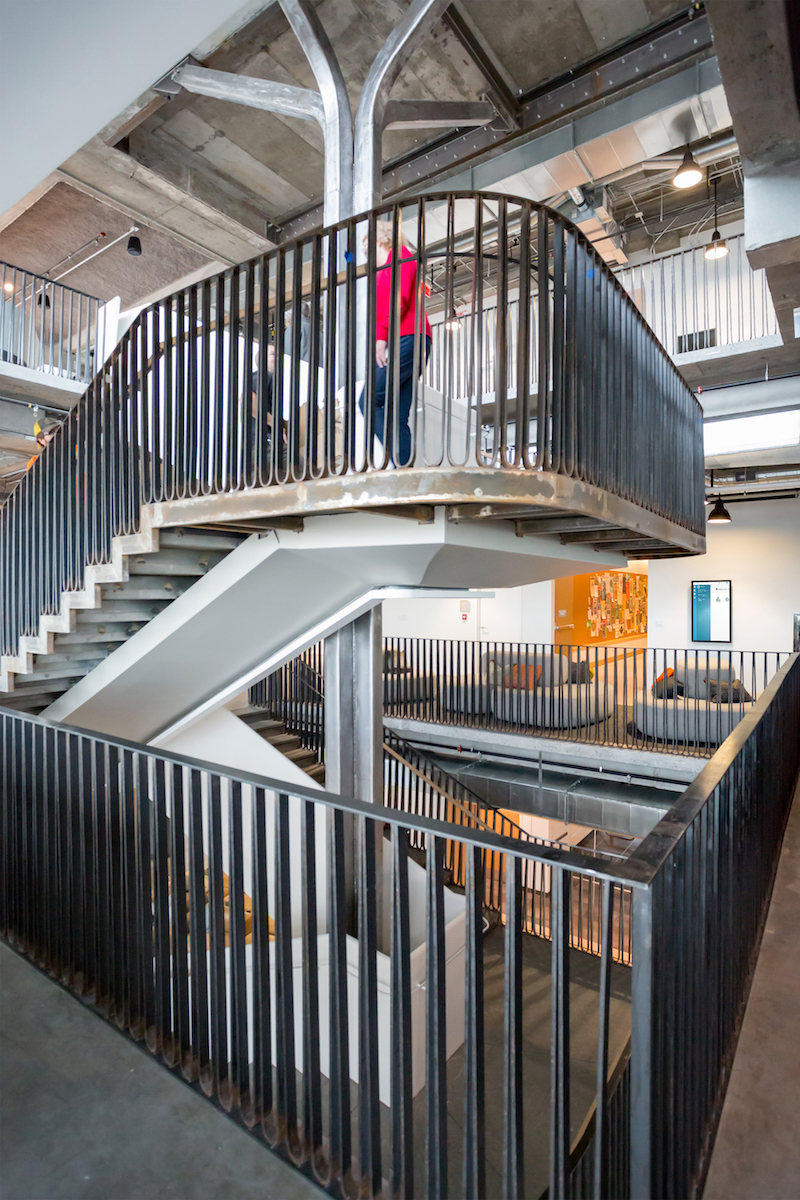AEC firms that have been pushing wellness for years say they finally have a receptive ear with developers and owners. “Developers sell this; they see it as an exciting new trend,” says Colin Rohlfing, AIA, LEED AP, Vice President and Director of Sustainability with HDR.
The advice about wellness these firms dispense to clients in many cases has already been road tested to make their own workplaces healthier.
New Orleans-based Eskew+Dumez+Ripple positions wellness to clients as “asset opportunities,” such as yoga rooms and classes, with the goal of keeping employees active, says Ian O’Cain, AIA, Associate and Project Architect. One of his firm’s recent projects is a new 30,200-sf, two-story office building in New Orleans that serves as the corporate headquarters for general contractor Palmisano Group. The $9 million building includes an in-house gym and yoga studio, green space, an active stairwell, and a racetrack layout that creates a circulation path for employees. The narrow floorplate (55 feet wide) lets in lots of light.
One of DPR Construction’s recent projects is a new office space in Charlotte, N.C., for Little Diversified Architectural Consultants. Chris Gorthy, a Project Executive with DPR, says that before embarking on this project, Little’s management toured several WELL-certified buildings, including DPR’s office in Reston, Va.
Little’s Charlotte office takes up 60,000 sf over 2½ floors of an existing building. Wellness certification accounted for about $8 per sf of its $150 per sf cost (including furniture), according to Little CEO Phil Kuttner, AIA, LEED AP, WELL AP. Its wellness features include a monumental staircase, access to drinkable water throughout, and ample natural lighting. Gorthy says the biggest challenge was upgrading the building’s air quality, which required educating the project’s subcontractors, setting up a temporary containment system, and figuring out how the air system could be cleaned.
Kuttner says the company assigned a team within its company to monitor the office’s air and water quality, conduct employee satisfaction and productivity surveys, and issue reports.
Last November, Clark Construction became the first GC in the U.S. to be a Fitwel Champion. As part of that agreement, Clark has identified seven of its offices—in Baltimore and Bethesda, Md.; Chicago; Irvine, San Diego, and San Francisco, Calif.; and Seattle—to achieve Fitwel certification.
“This is a way for our company to break through to our employees about its concern for their healthier living,” says Fernando Arias, Clark’s Director of Sustainability. He observes, too, that many of his firm’s clients “are in the same boat” and are looking for ways to provide healthier work environments to their employees.
Take, for example, a mixed-used project in Maryland that Carr Properties is developing known as The Wilson & The Elm, a 930,000-sf building with 360,000 sf of office space and 460 for-rent apartments. (The demolished building this replaces had been known as The Apex.) Arias says the genesis of this project was a meeting he had in early 2018 with the developer’s CEO Oliver Carr, which led to a presentation about wellness that Arias’ team made to Carr executives last April.
Carr Properties now has four projects registered with Fitwel, and The Wilson & The Elm is likely to be the second certified, following another Clark-built project: Midtown Center in Washington, D.C.
What prompted Carr Properties to move toward wellness, says its Senior Director of Development Jason Bockenek, was “a combination of our outlook as long-term owners of real estate, and increased demand driven by sophisticated tenants, catering to a younger workforce.”
Related Stories
Mass Timber | May 31, 2024
Mass timber a big part of Western Washington University’s net-zero ambitions
Western Washington University, in Bellingham, Wash., 90 miles from Seattle, is in the process of expanding its ABET-accredited programs for electrical engineering, computer engineering and science, and energy science. As part of that process, the university is building Kaiser Borsari Hall, the 54,000-sf new home for those academic disciplines that will include teaching labs, research labs, classrooms, collaborative spaces, and administrative offices.
MFPRO+ New Projects | May 29, 2024
Two San Francisco multifamily high rises install onsite water recycling systems
Two high-rise apartment buildings in San Francisco have installed onsite water recycling systems that will reuse a total of 3.9 million gallons of wastewater annually. The recycled water will be used for toilet flushing, cooling towers, and landscape irrigation to significantly reduce water usage in both buildings.
Mass Timber | May 22, 2024
3 mass timber architecture innovations
As mass timber construction evolves from the first decade of projects, we're finding an increasing variety of mass timber solutions. Here are three primary examples.
K-12 Schools | May 13, 2024
S.M.A.R.T. campus combines 3 schools on one site
From the start of the design process for Santa Clara Unified School District’s new preK-12 campus, discussions moved beyond brick-and-mortar to focus on envisioning the future of education in Silicon Valley.
Sustainability | May 10, 2024
Perkins&Will’s first ESG report discloses operational performance data across key metrics
Perkins&Will recently released its first ESG report that discloses the firm’s operational performance data across key metrics and assesses its strengths and opportunities.
Sustainable Development | May 10, 2024
Nature as the city: Why it’s time for a new framework to guide development
NBBJ leaders Jonathan Ward and Margaret Montgomery explore five inspirational ideas they are actively integrating into projects to ensure more healthy, natural cities.
K-12 Schools | May 7, 2024
World's first K-12 school to achieve both LEED for Schools Platinum and WELL Platinum
A new K-12 school in Washington, D.C., is the first school in the world to achieve both LEED for Schools Platinum and WELL Platinum, according to its architect, Perkins Eastman. The John Lewis Elementary School is also the first school in the District of Columbia designed to achieve net-zero energy (NZE).
K-12 Schools | Apr 30, 2024
Fully electric Oregon elementary school aims for resilience with microgrid design
The River Grove Elementary School in Oregon was designed for net-zero carbon and resiliency to seismic events, storms, and wildfire. The roughly 82,000-sf school in a Portland suburb will feature a microgrid—a small-scale power grid that operates independently from the area’s electric grid.
Contractors | Apr 26, 2024
AGC releases decarbonization playbook to help assess, track, reduce GHG emissions
The Associated General Contractors of America released a new, first-of-its-kind, decarbonization playbook designed to help firms assess, track, and reduce greenhouse gas emissions on projects. The AGC Playbook on Decarbonization and Carbon Reporting in the Construction Industry is part of the association’s efforts to make sure construction firms play a leading role in crafting carbon-reduction measures for the industry.
Mass Timber | Apr 25, 2024
Bjarke Ingels Group designs a mass timber cube structure for the University of Kansas
Bjarke Ingels Group (BIG) and executive architect BNIM have unveiled their design for a new mass timber cube structure called the Makers’ KUbe for the University of Kansas School of Architecture & Design. A six-story, 50,000-sf building for learning and collaboration, the light-filled KUbe will house studio and teaching space, 3D-printing and robotic labs, and a ground-level cafe, all organized around a central core.

















